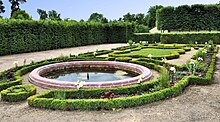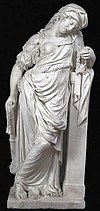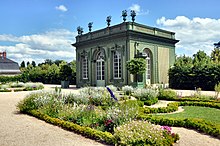Pavilion frais
The Pavillon frais or Salon frais is a folly designed by the first court architect Ange-Jacques Gabriel for King Louis XV. and whose mistress Madame de Pompadour was built. It is located in the French garden of the Petit Trianon , in the palace gardens of Versailles .
The Pavillon frais was added to the Petit Trianon because the king wanted a building to be able to move away from the constraints of court life. It was built between 1751 and 1753, is located opposite the Pavillon français and served as a dining room. The pavilion, which has only one room, is designed as a park building and is completely clad on the outside with green battens. It is embellished by a rectangular and symmetrical garden, which was bordered by arcades, which in turn were surmounted by wicker planters. The entire complex offers architectural and horticultural harmony. Two oval water basins at the ends of the parterres complete the decoration.
After the French Revolution , the building was left to weather and decay. In 1810 the pavilion was demolished and the garden replaced with a lawn. In the 1980s and again in 2010, patrons first enabled excavations and later the reconstruction of the building according to the original plans. The garden was also redesigned based on the original sketches. Only the arcades have not yet been rebuilt.
Building history
After the death of his mistress Madame de Châteauroux in 1744, King Louis XV moved. back at the Grand Trianon . He had neglected this castle during the first years of his reign, so that it was affected by the lack of maintenance. In 1747 his architect Ange-Jacques Gabriel and the director of the royal buildings Charles François Paul Le Normant de Tournehem made the first proposals on how to restore the comfort of the castle. The Countess Pompadour, who at that time had been the king's new mistress for two years, supported this project in order to distract the king from his melancholy. In 1749 work began on building a menagerie consisting of a courtyard and a stable on the land northeast of Jules Hardouin-Mansart's castle . In the middle of a new French garden , a pavilion was to be built, which was dedicated to games, snacks and concerts, which later became the pavilion français .

When the new fruit and vegetable garden was laid out by Claude Richard in the north and east of the complex , Louis XV. build a dining room near the French Pavilion. Because of its northward orientation, it was quickly given the name Pavillon frais or cooler pavilion . It was used to enjoy the products of the vegetable garden and the menagerie's dairy. After a few suggestions that the architect Gabriel had made to the king, Tournehem signed the building contract on September 17, 1751. The foundation was made in round arches to protect the building from moisture. It was completed in 1751 by the Thévenin brothers. The following year, the walls were made of limestone from Satory . The flat roof was completely covered with lead. The windows were made by the royal glass and mirror manufactory and installed in July. They consisted of more than 150 discs. The building offers wide views towards the gardens; it has a large central door and two glazed side doors as well as two large front windows. It has a sober structural concept and is only adorned with an arcade above the entrance area, which makes it reminiscent of the French pavilion or the nearby aviary . Its specialty is the lath cladding, which was made by Langelin and which reminds of the garden and nature.
The completion of the Pavillon frais in 1753 also ended the first construction phase by Gabriel on the Petit Trianon. Then the plant was given to the gardeners and botanists for design. Eight years later, the second construction phase began with the construction of the small castle.
King's private garden

The French garden has the shape of a Latin cross and the pavilion frais is at the end of the south arm of this cross. Opposite him is the menagerie. The avenue that begins in front of the Pavillon frais leads to the Pavillon français and is wide enough to allow a direct view between the two buildings. In front of the pavilion is a rectangular garden 50 meters wide and 20 meters deep. It was completely surrounded by arches made of trellis . The arcades, which were in line with the north facade of the pavilion, consisted of individual iron frames that were about 3.50 meters high and 2.35 meters wide. They were delivered by the locksmith Gamain the Younger (Louis or François Gamain) in July 1752. These frames supported the trellises that enclosed the trunks of linden trees . The treetops of these linden trees were cut into spherical shapes. The entrance was framed by two sturdy pillars that held large baskets. The paths were covered with river sand.
On both sides of the Pavillon frais there was a second row of arcades, creating two corridors that could be entered from the pavilion through the two glass side doors. At the ends of these two paths two trellis niches were made, in which two statues by David Bourderelle were placed in 1756. They came from the collection of antiquities in the palace gardens of Versailles. The statues with the names "La Maladie" and "La Santé" ( illness or health ) were originally intended as grave decorations. The arches of all 54 arcades were surmounted by basket planters that resembled the four acroteries on the roof of the pavilion.
All arcades, posts and the facades were clad with decorative trellis. It was supplied by Langelin, who was involved in numerous other buildings in Versailles. The trellis as well as the large ornamental baskets were painted green. In September 1753, Louis XV. his gardener Jean-Baptiste-Louis Belleville planted 40 orange trees in the arcades after several attempts had failed. A toilet near the building for the officers of the Guard Corps was covered with trellis.
The two symmetrical parterres were planted with night violets , gold lacquer and carnations . Each bed has an oval water basin on the sides facing the entrance, in which goldfish were kept at the request of the king . At the other end of the beds were palmettos of boxwood planted. The fish tanks were massive due to their original shape and needed special reinforcement to prevent cracks. The clay sub-floor is more than a meter thick. The floor was covered with cobblestones and colored sandstones that formed geometric motifs. The edge of the fountain was made in Languedoc marble by Louis-François Trouard .
Interior of the pavilion
Although the interior of the pavilion is only a good 60 square meters, it is richly decorated. The walls are clad with oak paneling made by the carpenter Jean-Antoine Guesnon. They are decorated with carvings by Jacques Verbeckt and painted in white and green by King Médard Brancourt's court painter. Two of these paneling have been preserved and were exhibited in the French Pavilion, and since 2008 they have been back in their original place. The frames of the three mirrors are the same shade of green. On May 30th, 1752 the fireplace was made of Languedoc marble, the same material as the basin edges of the goldfish tanks. Since the pavilion frais was only used in summer, the fireplace was not useful for anything other than its own display. In the middle of the white ceiling, a lamp was attached, which was decorated with garlands of porcelain flowers, similar to those in the Pavillon français . Two lights with three arms each hung on the walls. The five doors and windows were decorated with double white taffeta curtains. The floor was white and black marble.
There is nothing left of the furniture today. In 1776 it consisted of two white sofas with gilded borders covered with Persian white and green fabric. The two armchairs and 18 chairs had the same decor. In 1754 a large carpet was ordered from the Savonnerie manufactory and delivered in 1760. Its chevillon pattern featured the king's monogram in the center and lilies in the four corners as a camaieu painting. After the French Revolution he came to the Palais du Luxembourg in 1796/97 . In 1807 he was in the Hôtel d'Elbeuf by Jean-Jacques Régis de Cambacérès ; then his traces are lost.
Decay
Due to the start of construction on the Castle of the Petit Trianon in 1762, changes were made to the French garden between the menagerie and the Salon frais. The garden of the Salon Frais continued to be tended and the latticework was regularly repaired, but the parterres were simplified so that one could concentrate on furnishing Marie Antoinette's English garden. The French Revolution accelerated the decline of the facility. On January 31, 1793, the lead with which the roof was covered was stolen. This led to the ceiling falling a short time later. The window panes have been removed and stored in the pool room of the Petit Trianon. Three years later, the oak paneling, the marble of the floor and the fireplace were dismantled and brought into the kitchens of the Petit Trianon. The two sculptures by Bourderelle were sent to the Saint-Cloud castle .
Due to the poor structural condition, which had already been determined in 1796, the pavilion frais was demolished in 1810 after Guillaume Trepsat , the architect of Napoleon Bonaparte , estimated the cost of the renovation to be very high. The foundation, however, was retained and some of the building material was recycled for Marie-Louises Jeu de Bague . The fish tanks were filled in and the flower beds disappeared completely.
New building
In 1980 it was decided to build the new pavilion to receive guests there. A new reinforced concrete foundation was laid over the original foundation and the new building was completed in 1984. However, it was only superficially decorated by adding simple trellises. The pavilion was not used for receptions. Several excavations were carried out between 2006 and 2009, which Annick Heitzmann led under the leadership of the chief architect for architectural monuments Pierre-André Lablaude . Their aim was to secure the historical knowledge and to carry out the new building project as precisely as possible according to the historical model, both in terms of the architecture and the interior, the garden or the water basin. At the same time, research into the estate of the entrepreneur Langelin was completed, whose sketches and drawings allow very accurate replicas of the original decoration.
The budget for the restoration of the Pavillon frais and its garden is two million euros. Thanks to a donation from The American Friends of Versailles , the first phase was to restore the façade cladding with trellis, the six vessels on the roof and the posts at the garden entrance. In a second phase, the new construction of the arcades and their cladding with trellis and the completion of the interior of the pavilion are planned. So far, only the two original oak paneling that has been brought back from the pavilion français has been installed there.
Although the Pavillon frais was only built in 1984, it is protected in France as part of the Palace of Versailles as a Monument historique according to the decree of October 31, 1906. Since 1979 it has also been a UNESCO World Heritage Site . It is open to the public.
Web links
Individual evidence
- ^ Jérémie Benoît : Le Grand Trianon: Un palais privé à l'ombre de Versailles . Éditions du Gui, 2009, ISBN 978-2-9517417-8-2 , pp. 134 .
- ^ A b Annick Heitzmann : Trianon: Le Pavillon frais en son jardin . In: Versalia . No. 10 , 2007, ISSN 1285-8412 , p. 58 .
- ^ Jérémie Benoît: Le Grand Trianon: Un palais privé à l'ombre de Versailles . Éditions du Gui, 2009, p. 136 .
- ↑ Nicolas Jacquet: Secrets et curiosités des jardins de Versailles: Les bosquets, le domaine de Trianon, le Grand parc . Parigrams, Paris 2013, ISBN 978-2-84096-814-6 , pp. 115 .
- ↑ a b c d Christian Baulez, Michel Gallet and Yves Bottineau : Les Gabriel . Éditions Picard, Paris 2004, ISBN 2-7084-0721-X , p. 172 .
- ^ Annick Heitzmann: Trianon: Le Pavillon frais en son jardin . In: Versalia . No. 10 , 2007, p. 60 .
- ↑ a b c Annick Heitzmann: Trianon: Le Pavillon frais en son jardin . In: Versalia . No. 10 , 2007, p. 72 .
- ^ A b Annick Heitzmann: Trianon: Le Pavillon frais en son jardin . In: Versalia . No. 10 , 2007, p. 64 .
- ^ A b Pierre-André Lablaude : La restauration du Pavillon frais. In: YouTube. June 30, 2010, accessed June 13, 2018 .
- ↑ a b c Annick Heitzmann: Trianon: Le Pavillon frais en son jardin . In: Versalia . No. 10 , 2007, p. 66 .
- ^ A b Gustave Desjardins: Le Petit Trianon: Histoire et description . L. Bernard, Versailles 1885, p. 6th f .
- ↑ Château de Versailles, Le domaine de Marie-Antoinette: Les Jardins à la française. chateauversailles.fr, accessed May 2, 2013 .
- ^ Annick Heitzmann: Trianon: Le Pavillon frais en son jardin . In: Versalia . No. 10 , 2007, p. 67 .
- ^ Annick Heitzmann: Trianon: Le Pavillon frais en son jardin . In: Versalia . No. 10 , 2007, p. 68 .
- ^ Annick Heitzmann: Trianon: Le Pavillon frais en son jardin . In: Versalia . No. 10 , 2007, p. 69 .
- ↑ 1797 Création du musée spécial de l'École française. In: chateauversailles.fr. Versailles Palace, accessed June 13, 2018 .
- ^ Annick Heitzmann: Le domaine de Trianon sous le Premier Empire . In: Versalia . No. 7 , 2004, ISSN 1285-8412 , p. 125 .
- ^ Annick Heitzmann: Trianon: Le Pavillon frais en son jardin . In: Versalia . No. 10 , 2007, p. 73 .
- ↑ a b Press release: Restitution du décor extérieur du Pavillon frais. In: chateauversailles.fr. Versailles Palace, June 28, 2010, accessed May 13, 2013 .
- ↑ Jean-Jacques Aillagon : Conference de presse. In: chateauversailles.fr. Versailles Palace, December 11, 2007, accessed June 13, 2018 .
- ↑ Le treillage de Tricotel, c'est toute une histoire. Maison & déco, June 6, 2010, accessed May 13, 2013 .
- ↑ Le Pavillon frais. Versailles Palace on Facebook, July 1, 2010, accessed on May 13, 2013 .
- ↑ PA00087673 Domaine national de Versailles in the Base Mérimée of the French Ministry of Culture (French)
- ↑ Entry on the website of the UNESCO World Heritage Center ( English and French ).
Coordinates: 48 ° 48 '53 " N , 2 ° 6' 28" E




